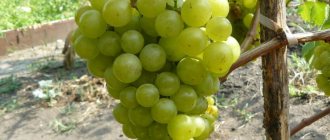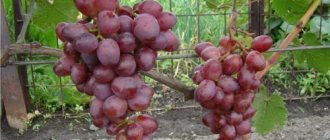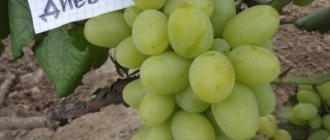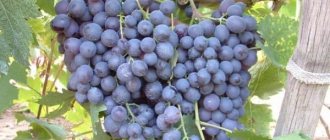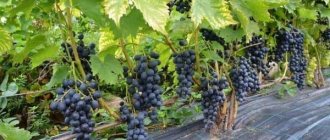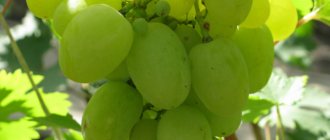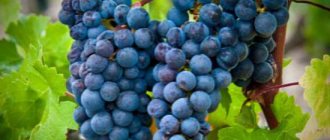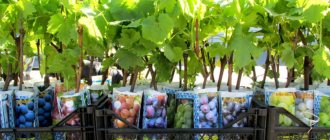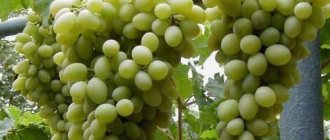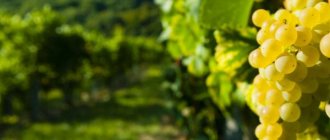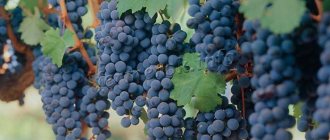History of selection
Oriental grapes come from Syria, Egypt, and Saudi Arabia. The variety is widely distributed in America and Europe. There is no reliable information about how and when the variety appeared. It is known that this is a very ancient culture. Syria is considered the homeland.
The largest bunch of early nutmeg was grown in Chile, weighing 8600 g. Fedor Ilyich Shatilov slightly improved the southern variety, making it more resistant to harsh climatic conditions. Currently, white nutmeg is grown throughout Russia, but grows better in the southern regions.
Tips for growing and caring
In order to properly grow Muscat grapes, you need to consider these recommendations:
- For the winter, almost all muscats need to be covered, even if they are quite resistant to frost. Especially if the plants are grown in cold regions with harsh winters. At temperatures below -25 °C, many nutmegs begin to die.
- For a full-fledged plantation covering a large area, a drip irrigation and soil spraying system is required. It needs to be “activated” during active grape growth. As soon as the berries begin to ripen, the number and volume of watering must be reduced, otherwise the harvest will be watery and unsweetened.
- Muscats must be processed every year, preferably in early spring or autumn. For treatment, you can use Quadris, Paracelsus, Sirocco or other products belonging to the group of insecticides/fungicides. These drugs are used to control diseases and pests. Insecticides are intended to kill insects, fungicides are intended to prevent fungal diseases.
In order to provide ideal conditions for the grapes, you need to use a trellis - a special design that provides good support for the plant.
You should also periodically (once every 2-4 weeks) loosen the soil between the rows and near the roots of the seedlings, without touching the plant itself.
Description of the variety
White super-early nutmeg is cultivated in regions with a warm, temperate climate. Ripening period is about 100 days. Up to 10 kg of berries are harvested from one bush. The taste characteristics of the fruit are high. The berries are juicy, sweet, with a thin skin.
The taste has a hint of nutmeg, citrus, and a light aroma of rose. Experts set the tasting assessment at 8.5 points.
The bushes are of medium height, highly branched. The culture requires constant care - gartering, pruning, crown formation. The foliage is dense, light green, and eventually wine-red in color. The plant is capable of self-pollination, since flowers develop in both sexes.
The bunch is cylindrical or conical. The diameter is 18 cm, the maximum length is 12 cm. The average weight of the bunch is 300 g. The color of the berries is golden with a greenish tint. The berries are round in shape and have a coating on the skin. Inside the berry there are 2-3 seeds of quite large size.
Appearance
Experienced winegrowers know that the vines of different plant varieties are not much different. You can identify a particular crop by its supports, trellises, row spacing, pruning methods, and garter. When planting muscat grapes, you must immediately take into account all the characteristics of the crop, choose a suitable place, and provide proper care.
- The bush is medium-sized, highly branched. Needs support and a garter.
- The foliage has 3-5 lobes. Thick. Shrubs need to be thinned out in a timely manner.
- On one young shoot, 1-3 full-fledged bunches grow with an average weight of 300 g. In conditions of excessive humidity, the cuttings rot, the berries fall off, and in dry weather the grapes do not gain the required amount of juice.
- From 1 hectare of plantation, 100 centners of berries are harvested. To increase productivity, artificial hand pollination and fertilizing are recommended.
Gardeners consider white super-early nutmeg one of the best varieties for growing in our area. The berry is valued for its high taste.
What type does it belong to?
This grape variety “White Muscat” is very early, belongs to the technical variety and is characterized by a high ability to accumulate sugar (25%).
Among the muscats, it is also worth paying attention to Novoshakhtinsky Muscat, Dievsky Muscat, Summer Muscat and Hamburg Muscat.
Application of grapes
Table grapes are actively consumed fresh and used for making juices and valuable dessert wine. The unique taste and unforgettable aroma make this berry desirable on every holiday table.
Fleshy berries with a dense peel are used to prepare fruit, vegetable, meat salads, desserts, compotes, and jams. In areas of mass cultivation, the berries are used exclusively for fresh consumption and the preparation of expensive wine.
Currently reading: What are the benefits of seedless grapes, what are the characteristics of different varieties
Advantages and disadvantages
Extra early white nutmeg is valued for the following positive qualities:
- high productivity;
- good transportability;
- long-term storage;
- standard care;
- universal purpose;
- early fruit ripening;
- The berries hang on the bunch for a long time and do not fall off.
Among the disadvantages, gardeners note the following:
- low immunity to diseases and garden pests;
- poor frost resistance;
- additional pollination is required to increase yield;
- capricious in care.
With proper care, all defects will be eliminated. If you leave everything to chance, you won’t be able to get a tasty grape harvest. The culture does not tolerate thickening, excessive humidity, dry weather, and freezes in winter without shelter.
What causes it and how to treat it
Very early grapes do not have strong immunity, so it is necessary to promptly treat the bushes against pests and carry out preventive measures against diseases.
Diseases of white nutmeg:
- gray rot;
- oidium;
- mildew;
- phylloxera;
- powdery mildew;
- anthracnose
During the rainy season, the risk of vineyard infection with gray rot increases. To prevent mass damage, leaves are removed in a timely manner and overgrowth is not allowed. It is recommended to plant the vine in a sunny, elevated place.
During drought, the risk of infection with spider mites and phylloxera increases. In this case, timely watering and leaf irrigation are recommended. The use of insecticides is indicated before fruit formation. This is done in early spring before the flowers bloom.
As for Shatilov’s white nutmeg, this variety is resistant to diseases, pest attacks and tolerates winter well.
How to avoid diseases?
Drugs that contain sulfur are used against this disease. The finer the form of sulfur present in the drug, the more effective the drug against oidium will be. The fungal cells absorb the sulfur and die.
Mildew or the so-called downy mildew is considered an equally dangerous disease. When a grape leaf is infected with this fungus, the affected areas become light in color. If it rains soon, a white fluff appears on the bottom of the leaf, and this is how this mushroom develops. Then the disease spreads to all other parts of the grapes. As the disease progresses, the leaves turn yellow and curl.
To avoid damage to grapes by this fungus, you must adhere to the following standards:
- Careful care is required.
- Preventive measures using chemicals.
- In the autumn, prevention can be carried out twice to protect the variety.
In addition, you need to carefully inspect the grapes, including red muscat.
Landing rules
Regions with a warm climate and average humidity levels are suitable for mass cultivation. Experts believe that the variety is not suitable for small farms. The crop requires careful care, and the berries are best used for making expensive wines.
However, if an amateur gardener decides to pamper himself with exclusive grapes, no one has the right to prohibit him. It is worth considering that early nutmeg does not like loamy, clayey soils, or soils with high acidity. If not properly cared for or in the wrong place, the yield will be weak and the berries will have poor taste.
How to choose quality seedlings when purchasing
Externally, seedlings of different varieties are no different. The type of crop can be determined 2-3 years after planting, when the first berries appear. Therefore, you should buy seedlings from trusted sellers. The cost of one scoop of extra-early white nutmeg is about $5. If the purchase is made on the market, you need to know several rules for a successful purchase.
- It is better to buy the vine immediately before planting it in the ground in a permanent place.
- The optimal age for a baby is 1 year. Two-year-old seedlings are poorly accepted, and an adult plant will dry out completely from the first days.
- The height of a one-year-old vine should be 55 cm, the thickness of the stem should be about 0.5 cm. The vine should have 2 shoots.
- The color of the seedling is brown. You cannot buy yellow or green shoots. The bark should be uniform, smooth, without spots or damage.
- A healthy trunk has at least 4 healthy buds.
- The root system must be well developed. Processes – at least three 15 mm each.
- A healthy grapevine does not break when bent.
Currently reading: Which grapes have more calories: black or white?
A conscientious seller either demonstrates the freshness of the seedling himself or gives buyers the opportunity to check.
Where to plant on the site
The southern plant needs sun. Moderate humidity, good ventilation. A place for planting a vineyard should be chosen that is sunny and protected from the wind. The depth of groundwater flow is 4-5 m from the surface.
For full growth of the crop, seedlings are planted in black soil, on rocky, loamy soils. Experienced winegrowers add gravel to the soil when planting. This provides good ventilation to the root system and prevents moisture stagnation. The best place is a hill, a hill.
How to plant
It is recommended to plant seedlings in the middle or end of May. Preparation of planting material begins in April. Soaked in growth stimulants. Autumn planting is allowed, but then the harvest will have to wait a year longer.
If there is more than one vine, they are planted in rows. The row spacing is 2-3 m. The soil is well watered, black soil and fertilizer are added. Potassium supplements are recommended. The seedling is placed in a hole, the roots are straightened, covered with earth, watered, and mulched. Sawdust, straw, grass, and earth are used as mulch.
The pit should be 1 m deep. A drainage layer of stone, crushed stone, and gravel is laid on the bottom. The earth is mixed with humus, black soil, sand, fertilizers, and the hole is filled halfway. The rest of the soil is sprinkled on the seedling after planting. It is recommended to install spikes near the vine and stretch ropes so that you can see where the grapes begin to grow.
Characteristics of the bush
Winegrowers know that at first glance, grape bushes of different varieties differ little from each other. The differences most often lie in the needs of the plant: supports, trellises, pruning and tying methods, the width of rows and row spacing. Grapes are a perennial plant, which means all the nuances need to be thought out in advance.
Vine
The liana is finally formed by the second year of growing the bush. The vine is characterized by low resistance to stress - without garter, the branches can simply break under the weight of ripening bunches. The shoot must be given direction immediately after spring pruning, and the lateral non-fruit-bearing shoots that grow throughout the growing season must be removed. The tendrils of the vine are fragile and often are not enough to secure them to the supports.
The muscat grape bush is medium-sized. The foliage has on average from 3 to 5 lobes, at the ends of which there are narrow and triangular teeth, but there are leaflets without teeth.
Bunch
Clusters on one shoot grow 1-3 full clusters. An unpleasant feature of white nutmeg is its tendency to pea. The bunches gain maximum weight only if all the requirements of the variety for climatic conditions and bush care are met. In conditions of high humidity, the cuttings of the bunch may rot, which leads to shedding of the berries. In dry times, the berries do not ripen and lose a lot of weight. The bunches must be collected exactly on time, otherwise you risk losing the harvest altogether. Read about harvesting and storing grapes in the fall here.
The bunch has a cylindrical shape, the weight of the bunch varies from 109 to 380 grams.
Productivity
High yields can only be achieved with careful care of plants.
The most important thing is to thin out the vineyard in time, avoiding thickening and excessive greenery. The yield of white muscat does not exceed the average statistical indicators of most varieties and amounts to 65-100 centners of berries per hectare of plantations
To increase this level, it is recommended to carry out additional manual pollination and the introduction of fertilizing.
The harvest is harvested quite late as the fruits ripen, but the accumulation of sugar in the grapes must be taken into account.
Features of seasonal care
Care measures for white Muscat are no different from other grape varieties. It is necessary to treat the crop against pests and diseases, apply fertilizer, water during drought, remove weeds, and loosen the soil around the vine. The crop is treated before flowering begins. Use copper sulfate, Bordeaux mixture, Topaz, Fitosporin.
Watering
Extra early white nutmeg does not tolerate waterlogging. In dry summers, an adult bush is watered twice a season. To ensure complete hydration of the root system, the ground around the vine is dug up, a ditch is made around it, and water is poured in. About 60 liters of water are poured under one bush.
Then the ground is leveled and mulched. If the summer is moderately rainy, additional watering is not required. It is recommended to water the bush before flowering to stimulate growth, during the formation of berries, so that they are juicier in the fall.
Young seedlings tolerate drought less well. At first they are watered every day. Gradually reducing soil moisture to once a month.
Top dressing
Grapes tolerate an excess of fertilizers much worse than a lack of them. During the season, an adult plant requires several feedings. At the same time, organic and chemical fertilizers are combined. The first fertilizing is applied in the spring before the leaves begin to bloom. Use a mixture of mineral fertilizers. Superphosphate, Potassium Sulfate, Urea.
Before flowering, apply organic fertilizer - chicken droppings, compost, manure. During the formation of berries, a second feeding is done with mineral preparations, but do not use nitrogenous agents. In the fall, after harvesting, it is recommended to enrich the soil with wood ash or humus. Young seedlings do not need additional feeding during 3 years of growth.
Support, shoot garter
White nutmeg forms wide bushes that need support and garter. Moreover, grapes need winter shelter. Therefore, you need to make a design that meets all these requirements.
Currently reading: What is the difference between Isabella grapes and how they are used
The basis is a stationary vertical support. Twine is pulled between it in 2-3 rows. The first tier is located at a level of 50 cm, 2 - 120 cm, 3 - 2 m. As the vine grows, it is pulled up to the trellis, young branches are directed upward.
Soil care
If the layer of earth around the vine is mulched, you need to periodically check the condition of the mulch. If there is no covering, you should regularly loosen the soil after watering or rain, and remove weeds in a timely manner.
Trimming
Bushes are prone to excessive branching. Leaves without proper care form a thick layer through which the sun's rays cannot penetrate. In this state, the yield drops, the berries crumble and ripen unevenly.
To avoid excessive branching, excess branches are removed in the fall, and pruning is also carried out “on a knot” to form young shoots. In the spring, excess buds are periodically removed, leaving 18 eyes on the bush. Each fruiting shoot should have 3 buds. Throughout the summer, pinching should be carried out, removing leaves and young shoots that do not have grape clusters.
Preparing for winter
In the southern region of the country, grapes tolerate winter well and do not require additional shelter or mulching. In areas with a temperate climate, where winter already arrives in November, a greenhouse for the vineyard or shelter for a separate bush is made for the winter.
The usual mulching of the root system with straw, sawdust, leaves, and pine branches is also suitable. Waterproof material is placed on top. The structure is removed at the end of April, when the temperature reaches above zero.
Muscat grape variety: white, pink, red
Muscats are usually called a whole group of varieties, united by a special subtle aroma inherent in the berries in a state of ripeness.
Among them there are both table and table-technical varieties. Muscat wines are highly prized throughout the world. The technical grape variety Muscat white (Tamyanka, Ladanny) is probably the most ancient. It is common in Europe and the USA. It is customary to characterize a variety by the quality of the vintage wine produced from it. The best drinks are obtained in countries with a Mediterranean climate, therefore, in the territory of the former CIS, culture is best achieved on the Southern Coast of Crimea.
Description
Its clusters and berries are medium in size, yellow with a golden tan on the sunny side. The pulp is very juicy, tender and fragrant. Connoisseurs detect notes of floral scents, tea rose, citron, and honey in the aroma.
The ripening period is early-medium (140 days), while technical ripeness occurs later, with some wilting of the berries and, as a consequence, maximum accumulation of sugars. High sugar content is combined with sufficient acidity.
The yield is average; to increase it, additional pollination is carried out.
The bushes are medium-sized, the ripening of shoots is good. They are grown on trellises, fan molding is used, and pruning is done to 6-8 eyes. Harvests are best achieved in poor soils with average moisture.
| Color | yellow |
| Form | rounded |
| 3-4 g / 0.3 kg | |
| 4,3 / 5 |
| Term | early-middle |
| average | |
| -21°С | |
| weak |
White Muscat loves potassium supplements.
A feature of the culture is the early beginning and end of the growing season, while the higher the vineyard above sea level, the shorter the growing season - buds bloom later, and leaf fall occurs earlier.
Resistance is low - it is affected by oidium, mildew and gray mold, and among the pests, spider mites and leaf rollers often settle on the leaves. Frost resistance is low.
Growing
Sheltering a crop for the winter is a rather labor-intensive undertaking, which has many nuances depending on the location of its growth. You can do without it only where the temperature never drops below -16°C. Each region has its own nuances of viticulture, so the best way to reliably find out is in your neighborhood.
Before covering, the vines must be prepared: removed from the trellises, leaves and unripe parts are removed and pickled with iron or copper sulfate. Traditionally, grapes are covered with earth, but in this case, during thaws, the buds may dry out.
Many people practice leaf insulation, build tunnels from boards and slate laid on top, or build gable roofs from plywood and roofing felt. Some use film, fiberglass or agrofibre. When covering plants, it is recommended to place mouse bait inside to prevent them from chewing on the vines, and to provide ventilation options for warm days.
Muscat pink: description
Based on the white form, a variety of Muscat pink was developed in Europe several centuries ago - early ripening, tableware. Its clusters are slightly larger, up to 0.2 kg, the berries are round, with very juicy pulp and thin skin with a waxy coating. Color – from pink to dark red.
The ripening of the crop begins already 110 days after the start of the growing season, but technical ripeness occurs after about 140 days, with the greatest sugar accumulation.
| Color | pink |
| Form | round |
| 4-5 g / 0.2 kg | |
| 4,3 / 5 |
| Term | early |
| average | |
| -21°С | |
| vulnerable |
Bush growth vigor and yield are average. Pink nutmeg is affected by fungal diseases a little less than white nutmeg. In addition, it has low frost resistance and drought resistance, so it is cultivated mainly in the south; the best yields are obtained in the Southern Crimea.
However, all the difficulties in growing this valuable form are compensated by the quality of the main processed product. It is used to produce dessert or liqueur wines with a beautiful pink color. The quality of the drink depends very much on the year of collection; the most successful bouquet is considered to be the presence of the aroma of Kazanlak rose.
Muscat summer
For fresh consumption, breeders from Moldova developed a table variety – Summer Muscat. Summer residents and gardeners highly recommend it for home gardening. According to reviews, sweet aromatic berries make this form of Muscat one of the best.
Summer nutmeg ripens early (110-120 days pass from bud break). The variety boasts fairly large berries (7-8g) with fleshier pulp than the white one. Their color is yellow-green, and their shape is elongated. Traditionally, high sugar content (17-20%) is combined with low acidity (6-8 g/l). Transportability is good.
| Color | yellow-green |
| Form | elongated |
| 7-8 g / 0.6 kg | |
| 4,7 / 5 |
| Term | early |
| high | |
| -25°С | |
| average |
It is also more resistant to fungal diseases than its white counterpart: to mildew by 3-3.5 points, and to oidium by 3 points. The frost resistance of the hybrid is also pleasing: it can withstand down to -23°C. However, winegrowers recommend cultivating it in a covered form.
Muscat extra early red
And one more table variety belonging to the noble family of Muscats is the super-early red (form No. XVII-10-26), which was also bred by Moldavian breeders.
Its “zest” is its exceptionally early fruiting (ripening period 95-100 days). The harvest begins in the second half of July, however, according to reviews from winegrowers, after that it can easily hang on the bush for another couple of months.
Externally, the shape is very similar to the famous Cardinal variety.
The mass of the bunches is 0.3-0.6 kg, the berries are 4-5g, they are red-violet in color. Red nutmeg is famous for its harmonious taste, and its flesh has a pleasant crunch. Sugar content 15-18%, acidity 5-7 g/l. Transportability is high.
Depending on the level of agrotechnical background, bushes can develop medium or high growth vigor. Pruning - by 6-8 buds, leaving about 40 eyes per plant.
| Color | red |
| Form | rounded |
| 4-5 g / 0.3 kg | |
| 4,5 / 5 |
| Term | early |
| average | |
| -23°С | |
| average |
Resistance is average to both oidium and mildew. The form can withstand temperatures down to -23°C in winter, and like all nutmegs, it needs shelter for the winter. A feature of the form is the so-called “accumulation of old wood” - when the size of the berries and bunches increases with the age of the plants.
Reviews
The “family” of Muscats does not end there; among the lesser-known varieties is Muscat Ottonel, presented in the video:
Some argue that White Muscat's weak point is its susceptibility to gray mold in rainy years. Opinions are also divided regarding resistance to wasps. Some nurseries claim it is high, while others indicate that due to the honey aroma emitted by ripe grapes, efforts must be made to protect the crop from wasps.
In any case, it is not for nothing that Muscat grape varieties are so popular, and many experienced winegrowers reserve precious space in the garden just for them.
Source: https://remontanta.ru/sorta-vinograda/180-vinograd-muskatnij-belij-rozovij-krasnij
